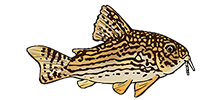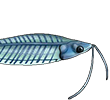L260 and stocking plans
L260 and stocking plans
In my 125L tank I plan to have a Queen arabesque pleco, 10 neons, 5 cory sterbai , 5 otos and 2 gouramis. The temp of the tank will probably be between 25-26. Would these fish be able to survive at this temp and what things will the l260 need apart from a small cave?
- apistomaster
- Posts: 4735
- Joined: 10 Jun 2006, 14:26
- I've donated: $90.00!
- My articles: 1
- My cats species list: 12 (i:0, k:0)
- My Wishlist: 1
- Location 1: Clarkston, WA, USA
- Location 2: Clarkston, WA, USA
- Interests: Aquaculture and flyfishing
- racoll
- Posts: 5258
- Joined: 26 Jan 2004, 12:18
- My articles: 6
- My images: 181
- My catfish: 2
- My cats species list: 2 (i:2, k:0)
- My aquaria list: 1 (i:0)
- Spotted: 238
- Location 1: London
- Location 2: UK
Depending on the species of Otocinclus it is unlikely that they will be happy at 30C.
I kept some at this temp for while and they were really stressed with very rapid gill movement.
I keep L262 (caught from the same location as L260) at 27/28 and they are very healthy and active.
Perhaps 27C is a good compromise, but keep a close eye on the otos.
If you want a small algae eater why not try . These clean up algae like no other, and can be kept at temps over 30C.
Also, why not get more L260. They will probably be more active in a group.
.
I kept some at this temp for while and they were really stressed with very rapid gill movement.
I keep L262 (caught from the same location as L260) at 27/28 and they are very healthy and active.
Perhaps 27C is a good compromise, but keep a close eye on the otos.
If you want a small algae eater why not try . These clean up algae like no other, and can be kept at temps over 30C.
Also, why not get more L260. They will probably be more active in a group.
.
- apistomaster
- Posts: 4735
- Joined: 10 Jun 2006, 14:26
- I've donated: $90.00!
- My articles: 1
- My cats species list: 12 (i:0, k:0)
- My Wishlist: 1
- Location 1: Clarkston, WA, USA
- Location 2: Clarkston, WA, USA
- Interests: Aquaculture and flyfishing
I overlooked the otos in the tank. I agree that 27C is probably better although I have 7 Common Otos in a tank that is maintained at 84dF and this group has lived for two years. That is very good mileage for me and common Otocinclus, perhaps the longest a group has lived for me. I have been surprised but discus were the main show and the preferences of the Otos weren't my main concern.
Hypancistrus, in general seem to do well for me at that temperature as well, again, being kept with discus.
I raise discus so many of my tanks are kept at 84F.
I don't know why but for some reason I was under the impression P. jumbo liked low 70'sF so I have kept them cooler than many of my other fish. Maybe they should be warmed up?
Hypancistrus, in general seem to do well for me at that temperature as well, again, being kept with discus.
I raise discus so many of my tanks are kept at 84F.
I don't know why but for some reason I was under the impression P. jumbo liked low 70'sF so I have kept them cooler than many of my other fish. Maybe they should be warmed up?
Avid Trout fly fisherman. ·´¯`·...¸><)))º>
- racoll
- Posts: 5258
- Joined: 26 Jan 2004, 12:18
- My articles: 6
- My images: 181
- My catfish: 2
- My cats species list: 2 (i:2, k:0)
- My aquaria list: 1 (i:0)
- Spotted: 238
- Location 1: London
- Location 2: UK
Hi Larry.
There is a lot of first hand info in Wels Atlas I on P. jumbo.
They are collected for the hobby near the city of Recife on the far eastern side of Brazil. This area is perhaps subject to greater seasonal variation than much of the amazon basin.
These fish are extremely hardy, and in the dry season are found in very polluted water as warm as 35C (95F).
The rainy season will be cooler than this and temps of 25-30C (77-86F) are recommended by the authors for general care.
I'm sure they would be fine at lower temps than this, as they do seem to be very adaptable.

There is a lot of first hand info in Wels Atlas I on P. jumbo.
They are collected for the hobby near the city of Recife on the far eastern side of Brazil. This area is perhaps subject to greater seasonal variation than much of the amazon basin.
These fish are extremely hardy, and in the dry season are found in very polluted water as warm as 35C (95F).
The rainy season will be cooler than this and temps of 25-30C (77-86F) are recommended by the authors for general care.
I'm sure they would be fine at lower temps than this, as they do seem to be very adaptable.
- apistomaster
- Posts: 4735
- Joined: 10 Jun 2006, 14:26
- I've donated: $90.00!
- My articles: 1
- My cats species list: 12 (i:0, k:0)
- My Wishlist: 1
- Location 1: Clarkston, WA, USA
- Location 2: Clarkston, WA, USA
- Interests: Aquaculture and flyfishing
Hey Racoll,
They are adaptable for sure. After my initial trial run at breeding them at lower 70's I had to combine them with some other fish in an interim arrangement. Now they are at 84dF with some Copella vilmae, half grown wild Peruvian scalares and my breeding colony of Corydoras sterbai. I'm in between sterbai spawns. My Corydoras duplicareous have begun laying eggs. Now that the Holidays are over I will set them up in a snail free spawning tank. I bought all the P. jumbo I found at a LFS and afterwards found I also had a trio of P. spilurus(Think that's the correct name) They are a very interesting little catfish in their own right. The female is so plump, too. I gave them their own space but they were very shy and did not spawn either but are now are very active and outgoing in a 36 gal planted tank stocked with all my L333, Sturisoma nigirostrum and a school of the blue/red fin Colombian Tetras. I have so many kinds of catfish now that it will take me years to work through them. I am trying to get two groups of 6 each L260 to spawn but so far no results yet.
They are adaptable for sure. After my initial trial run at breeding them at lower 70's I had to combine them with some other fish in an interim arrangement. Now they are at 84dF with some Copella vilmae, half grown wild Peruvian scalares and my breeding colony of Corydoras sterbai. I'm in between sterbai spawns. My Corydoras duplicareous have begun laying eggs. Now that the Holidays are over I will set them up in a snail free spawning tank. I bought all the P. jumbo I found at a LFS and afterwards found I also had a trio of P. spilurus(Think that's the correct name) They are a very interesting little catfish in their own right. The female is so plump, too. I gave them their own space but they were very shy and did not spawn either but are now are very active and outgoing in a 36 gal planted tank stocked with all my L333, Sturisoma nigirostrum and a school of the blue/red fin Colombian Tetras. I have so many kinds of catfish now that it will take me years to work through them. I am trying to get two groups of 6 each L260 to spawn but so far no results yet.
Avid Trout fly fisherman. ·´¯`·...¸><)))º>
- racoll
- Posts: 5258
- Joined: 26 Jan 2004, 12:18
- My articles: 6
- My images: 181
- My catfish: 2
- My cats species list: 2 (i:2, k:0)
- My aquaria list: 1 (i:0)
- Spotted: 238
- Location 1: London
- Location 2: UK
Well good luck if you do try breed them. I have just acquired a group of these, and I may also try. I shall let you know how I get on.
I also found a single P. spilosoma among the batch in the shop, so I bought her too.
The authors of Wels Atlas I are not convinced that the species commonly caught around Recife with P. jumbo is P. spilosoma. They are not sure that the description matches the fish accurately enough to be certain.
They prefer to refer to it as Parotocinclus sp. "Recife".
Apologies for hijacking the thread by the way.
I also found a single P. spilosoma among the batch in the shop, so I bought her too.
The authors of Wels Atlas I are not convinced that the species commonly caught around Recife with P. jumbo is P. spilosoma. They are not sure that the description matches the fish accurately enough to be certain.
They prefer to refer to it as Parotocinclus sp. "Recife".
Apologies for hijacking the thread by the way.





